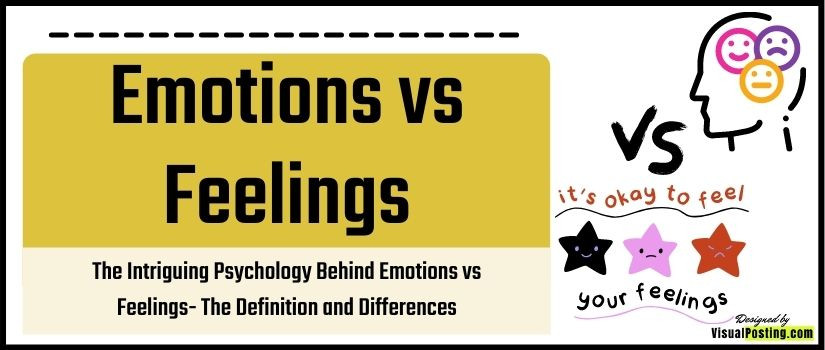
We all have feelings and emotions. And we show them in different states. When we are angry or sad, these emotions are much more visible.
Emotions and feelings may seem similar, but they are different. Feelings are conscious. While emotions are either conscious or unconscious.
Emotion vs Feelings
Definition of emotions and feelings
What are emotions?
Emotions can only be felt when you have gone through an event. Your emotions are not felt. But, instead, they are in your unconscious mind.
They are visible when you remember the event that has caused this emotion.
Emotions example can be;
- Joy
- Sadness
- Fear
- Anger
- Surprise
What are your feelings?
Feelings are both emotional and physical sense. Such as hunger or pain. Feelings are conscious you can feel them.
Although not every feeling is conscious, such as seeing or believing.
Difference between feelings and emotions
Below shows how different feelings and emotions are;
- Feelings are felt. But, emotions are unconscious in your mind. They give you information about the world. This is one of the key differences between emotions and feelings.
- Emotions aren’t known. Often, you do not feel that you are having an emotion.
- Feelings happen when you begin to feel the emotion. Feelings last longer than emotions.
Emotions vs feelings list
The main five categories of emotions are;
1- Anger
2- Fear
3- Sadness
4- Disgust
5- Enjoyment
- Enjoyment: we all generally like to feel happy, calm, and content. You might show these feelings by smiling or laughing.
- Sadness: we all feel sad from time to time. This emotion relates to an event, such as loss. You might feel lonely, lost, or unhappy.
- Fear: this emotion occurs when you sense any type of threat. It can range from mild to severe. Fear makes you feel nervous, worried, and stressed.
- Anger: usually occurs when you experience failure or unfairness. You feel mad, annoyed, and bitter.
- Disgust: you experience disgust as a result of bad situations. You might feel hate and uncomfortable.
Are your emotions and feelings the same?
Emotions and feelings are different, even though you may think they are the same. Emotions are rooted deep inside of us.
As emotions aren’t felt and shown, it is possible to bring these emotions out through therapy. You can still have emotions inside, without showing them to other people.
But, feelings are the result of emotions. Feelings are created when your brain gives sense to the emotion that you are having.
For instance, you can feel happy or angry. Feelings are noticeable. And they are brought up from your physical responses to many things.
You can feel pain, or if you haven’t eaten all day, you will feel hungry. Feelings and emotions are two different and they aren’t related.
Where do emotions come from
The limbic system from within our brain is responsible for our emotional responses. This system connects several structures, such as Amygdala.
The amygdala helps run the responses to things in your environment. Mainly those that cause an emotional response.
Emotions are deeply located in our brains. They aren’t shown or felt.
How do emotions work?
To know how emotions work, it is important to know what causes them.
Emotions are often caused by thoughts. For instance, you can be in the same situation with another person. But you both are feeling different emotions because you both have different thoughts.
It is found that certain thoughts lead to certain emotions. For instance, when you think, “I am in danger,” you would probably feel fear. Or when you get something you want, you would probably feel happy.
Emotional feelings most often depend on thoughts. What you are thinking might trigger an emotion. Sometimes you can feel emotion, even though you don’t notice any thoughts related to it.
However, sometimes your brain can trigger an emotion unconsciously, which means that your brain might notice something in your situation. And trigger an emotional response all without you even noticing it.
What happens during an emotion?
When an emotion is triggered, your brain changes what is happening in your body. And that causes physical responses to it.
For instance, when you are afraid, you feel your heart rate increase. And your lungs start breathing faster. Or when you are sad, you get tears in your eyes.
Emotions can also cause reflex muscle movement. Such as, when you are happy, you smile. And you might not even notice.
Another part is you also start thinking differently. For instance, when you are sad, you usually think about sad memories. But when you are happy, you think of happy memories.
The last part of an emotional reaction is that you want to behave differently. For example, if you are angry, you might want to yell. Or when you are scared, you want to run away.
Knowing emotions and how they work is useful to know. It helps you to know why you are feeling these certain emotions. And how to manage them.
Emotion frequency chart
The emotional frequency chart states your frequency rate or your vibration analysis. Normally, your metabolic rate is at rest. But when an event starts happening in your life, your vibrational rate changes quickly.
How are emotions created?
From the moment we are born, our emotions are built within us. And our minds start learning the defense reactions, which are stored deep in our minds.
As you go through each life event, most of your reactions become automatic. They are often negative emotional reactions.
These negative emotions are in your mind. By the time you are an adult, you are dealing with many unfinished events. You are stuck in a negative emotional cycle, which is based on long-forgotten memories.
Your negative emotional reactions and negative events become more frequent. It is a natural life lesson made to keep giving you a chance to see the pattern. And process it.
Some reactions that trigger negative emotions include; judging others, comparing yourself to others. Breaking this negative cycle is key in raising your emotional state. It helps you to feel higher-rate emotions such as; joy and love.
Your positive behavior helps in raising the emotional state. The vibration analysis frequency chart given shows the range between higher to lower emotions.
As the analysis gets lower, your ability to do things positively reduces. When you are in lower emotion frequency, it can be hard to deal with.
However, it is vital to seek help. And know your emotions. Observe yourself in how you react in situations, and look at why you reacted that way. If you try ways to reduce those negative emotions, you will greatly improve your life.
Difference between emotionally and psychologically
Emotionally and psychologically are close. But psychologically is more related to the mind, its health, and working. Whereas emotionally is related to feelings.
Psychology is more medical. Its impact would be to cause or increase your mental pain, such as a phobia. While the emotional impact is to make you scared or upset.
How to measure emotions and feelings
Emotions are measured through the emotion measurement scale. The emotional, cognitive scale was created to measure the children’s opinions of their own emotions.
Feelings can be measured by tools such as interviews and surveys, including feelings rating scale and feelings assessment.
How do feelings work
Feelings work just as you feel an emotion. Through emotions, you feel things. For instance, if you are angry, you feel mad. Feelings and emotions are related yet different.
If emotion is triggered, your feelings respond to it.
Feelings vs. Thoughts
As mentioned earlier, feelings are the conscious part of yours. They are the result of your thoughts.
Thoughts are mental processes. The link between your emotions and feelings. They represent your beliefs, opinions, and ideas. How you think about an experience will result in feeling.
Difference between feelings and thoughts
- Feelings make you aware that something unexpected is happening. It demands the mind to think.
- Thoughts are your ways of dealing with feelings. Ways of finding the solutions that are needed.
- Thinking comes from experience. It slowly develops. And teaches you how to manage your feelings, how to solve the problems that your feelings represent.
- Thoughts are placed between feelings and actions.
Feelings in psychology
Feelings psychology is the events within your body, which is closely related to emotions. It is known as the internal feeling of yours.
Many studies show that feelings are what you are experiencing. It triggers your emotions and causes bodily responses.
To sum up, feelings and emotions are both important in life. They are within you throughout your life journey. And they develop as you experience the events in life.
These responses help you know your surroundings. And cause you to react differently.
It is very useful to know your emotions, as they are always hidden. For a good life, seek help and improve your emotions.
While feelings are your visible responses. You feel many things in life. Often, you feel your emotions. Thoughts are in-between your emotions and feelings.
To deal with your feelings, you think of a solution. Our brain is a complex system dealing with multiple structures. Sometimes it does things without our notice. To know yourself, you must understand your emotions first.


